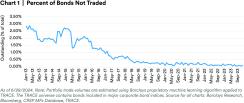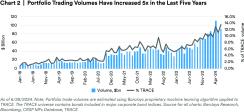Portfolio bond trading, a method of executing large baskets of bonds in a single transaction, is transforming the fixed income market. This innovation has the ability to significantly enhance liquidity across the entire bond market and offers another tool in toolbox for fixed income managers to access liquidity. Furthermore, asset managers who leverage portfolio trading in implementing fixed income credit strategies may gain a competitive edge by unlocking another source of alpha generation. Given the inherent inefficiencies in fixed markets despite recent advances, a thorough understanding of one’s role in such a transaction is essential to capturing the benefits of this growing form of trading.
Some of these new improvements may be of most benefit to those managers with significant scale and resources, but who are also nimble enough to take advantage of the unique opportunities that are often presented by this new paradigm shift in credit trading.
Portfolio Trading Improves Liquidity in the Bond Market Through Several Mechanisms:
Aggregation of Liquidity: Portfolio trading allows for the simultaneous execution of multiple bonds, effectively aggregating liquidity across different issues. This is particularly beneficial for less liquid bonds that might be challenging to trade individually.
Speed of Execution: By executing large baskets of bonds in a single transaction, portfolio trading reduces the time to transact that would occur if these bonds were traded separately. This is especially valuable for institutional investors managing large portfolios who now have the ability to efficiently reposition portfolios either adding or reducing risk almost instantaneously.
Improved Price Discovery: The ability to trade multiple bonds at once enhances price discovery across the market. Traders can more easily identify relative value opportunities and arbitrage between different bonds, leading to more efficient pricing.
Increased Trading Volumes: Portfolio trading facilitates larger trade sizes, which can increase overall trading volumes in the bond market. This increased activity can attract more participants, further enhancing liquidity.
The increased trading volumes has also translated to more individual CUSIPs trading, with the number of issues not traded on steady decline. The percent of bonds outstanding that have not traded has declined to 10 basis points from 70 basis points in 2018 – an 85% decline in just over 5 years. Looking back even further to 2013, it’s declined 97% from the highs of 2.90% of outstandings not traded.


Conclusion
The integration of portfolio trading with traditional fixed income over-the-counter investing represents a significant opportunity for asset managers to efficiently maneuver risk, while simultaneously providing another tool to enhance liquidity. While challenges remain, particularly around data quality, standardization, and pricing distortions - the synergies between these areas are likely to drive innovation in both trading technology and portfolio management practices.
Asset managers who can effectively leverage portfolio trading capabilities to implement investing strategies will be well-positioned to meet the growing demand for avenues to generate alpha in the fixed income space. As this integration continues to evolve, it will be crucial for market participants to stay informed about technological advancements, regulatory developments, and best practices in innovative portfolio construction and trading.
L0924043416 [0926] [All States]





